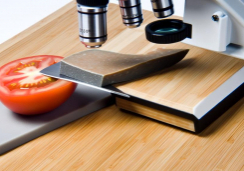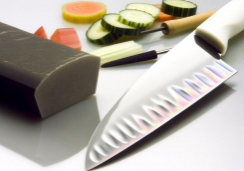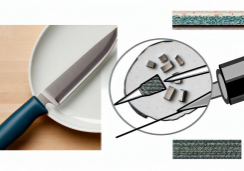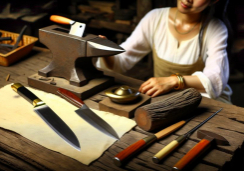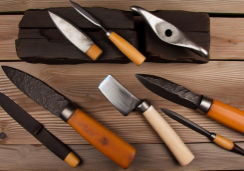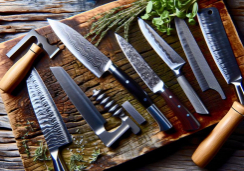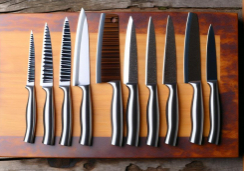Why Do Ceramic Kitchen Blades Lose Their Edge?
Ceramic kitchen knives captivate with their cutting-edge charm, offering a lightweight alternative to their metallic counterparts. You've likely invested in one, drawn by their reputation for retaining sharpness.
Yet, despite their durable designs, you find their once unyielding edges eroding over time. This enigmatic dulling demands a deeper understanding of the material science behind these modern marvels.
As someone who values the tools in your culinary arsenal, it's crucial to comprehend the common culprits that compromise your ceramic blades. Stick around, and you'll uncover the subtle nuances of ceramic wear and tear, and the best practices to ensure that your slicers stay sharp and serviceable, challenging the notion that these tools are impervious to the dull drum of decline.
Characteristics of Ceramic Blades
Ceramic blades, known for their exceptional hardness and sharpness retention, are crafted from zirconium dioxide, a material that allows for precision cutting but can be prone to chipping or breaking if mishandled. You'll find that their composition gives them a significant edge over traditional steel counterparts in terms of weight and resistance to acid, oils, and salts, which are prevalent in kitchen environments. Unlike steel, ceramic doesn't rust or corrode.
They maintain their edge up to ten times longer than steel blades, reducing the frequency of sharpening. However, when they do dull, the sharpening process requires specific tools like a diamond-dust-coated sharpening wheel, reflecting their inherent hardness. Their brittleness, while contributing to a keen edge, also means they're not suitable for tasks that require flexibility, such as boning or cutting frozen foods.
You must handle ceramic blades with care, avoiding lateral forces that can lead to cracks or complete failure. They're ideal for slicing fruits, vegetables, and boneless meats. It's crucial to use them on a proper cutting surface, such as wood or plastic, to prevent premature dulling. The technical design of ceramic blades provides a hygienic cutting edge, but it's their meticulous maintenance that ensures their longevity and performance.
Common Causes of Dulling
Despite their durability, improper use and maintenance can lead to your ceramic kitchen blades gradually losing their razor-sharp edge. The hardness of ceramic allows these blades to sustain a sharp edge for extended periods; however, they're not immune to dulling.
You'll find that one common cause of dulling is misuse, such as twisting or prying with the blade. Ceramic is less flexible than metal and can sustain microchips along the edge when used improperly. These imperfections may not be visible to the naked eye but contribute significantly to a loss of cutting efficiency.
Another factor is cutting on inappropriate surfaces. Hard surfaces like glass or stone can dull ceramic blades faster than softer materials like wood or plastic. It's essential to use a cutting board that's friendly to ceramic blades to avoid unnecessary wear.
Additionally, exposure to high temperatures can compromise the integrity of the blade. Ceramic is heat resistant, but sudden temperature changes can lead to microscopic cracks and eventually, a dull edge.
Lastly, improper storage, like tossing the blade into a drawer where it can knock against other utensils, can cause damage. Always store your ceramic knife in a protective sheath or designated knife block to maintain its edge.
Proper Handling Techniques
To preserve the longevity of your ceramic kitchen blades, it's crucial to master the correct handling techniques. Ceramic blades are composed of zirconium dioxide, which imparts exceptional hardness. However, this hardness comes at the cost of brittleness. Therefore, you must avoid twisting or flexing the blade during use. Always apply force in a straight, vertical direction to minimize lateral stress that can induce microchipping along the cutting edge.
Ensure you're cutting on a surface that's soft enough to not dull the blade, yet firm enough to support precise slicing. Ideal options are wooden or plastic cutting boards; avoid glass, metal, or stone surfaces. These can blunt the blade or even cause it to crack.
When slicing, use a smooth, rolling motion, and steer clear of hacking or chopping motions that can compromise the blade's integrity.
After use, hand-wash your ceramic blade with mild soap and warm water, then dry it immediately. Dishwashers can jostle the knife, leading to potential damage. Store the knife in a protective sheath or a dedicated knife block slot to shield the edge from inadvertent impacts.
Cleaning and Storage Tips
Maintaining your kitchen blades requires careful cleaning and strategic storage to ensure their longevity and performance. Ceramic knives demand particular attention due to their brittleness and susceptibility to micro-chipping. Clean them immediately after use, hand-washing with mild detergent and avoiding abrasive scrubbers that can compromise the blade's integrity. Dry them thoroughly to prevent any water spots or corrosion of the metal components on the handle.
Storage is equally critical. Don't toss your ceramic knives in a drawer with other utensils; the contact can dull the edge. Instead, invest in a knife block or sheath specifically designed for ceramic blades. These storage solutions cushion the knife, preventing unnecessary contact with hard surfaces.
Also, consider the environment where you store your knives. Extreme temperature fluctuations can affect ceramic materials, potentially leading to cracks. Keep them in a stable, room-temperature environment away from direct heat sources or cold drafts.
Sharpening Ceramic Blades
While proper storage and cleaning are vital for preserving your ceramic knives, they'll eventually require sharpening to restore their precision cutting edge. Sharpening ceramic blades demands a material harder than the ceramic itself, typically diamond, or a specialized ceramic sharpening tool.
Commence with a diamond sharpening rod or a specific ceramic knife sharpener designed for the task. Avoid conventional steel or stone sharpeners, as they're ineffective against the robust zirconium dioxide composition of ceramic blades. Apply gentle pressure and maintain the original blade angle, typically between 20-30 degrees. Execute consistent, controlled strokes along the length of the edge, ensuring uniform contact with the sharpener.
Monitoring the blade's edge for a burr, indicative of the sharpening process reaching its apex, is pivotal. Once a burr forms, it's crucial to minimize it by running the blade through a fine-grit sharpening stage or using a specialized tool for burr removal.
Post-sharpening, cleanse the blade with water to remove any ceramic dust, which is an abrasive residue resulting from the sharpening process. Dry thoroughly to prevent any potential for micro-fractures that can occur with moisture exposure.
Regular sharpening extends the life of your ceramic knives, ensuring sustained performance and precision in your culinary endeavors.
How Can I Prevent My Ceramic Kitchen Blades from Losing Their Edge?
To maintain ceramic kitchen knife sharpness, avoid cutting hard or frozen food, or using a glass or marble cutting board. Instead, opt for a wooden or plastic cutting surface. Cleaning the knife by hand with a soft sponge and mild detergent will also help preserve its edge.
Conclusion
In summary, you must handle your ceramic blades with care to preserve their edge. Avoid hard surfaces and impacts that can cause chipping.
Clean them gently, and store them properly to prevent dulling.
When they do lose their sharpness, professional sharpening is recommended due to the blade's hardness and brittleness.
With meticulous maintenance, your ceramic knives will sustain their keen edge, ensuring precise cuts and a longer lifespan.

